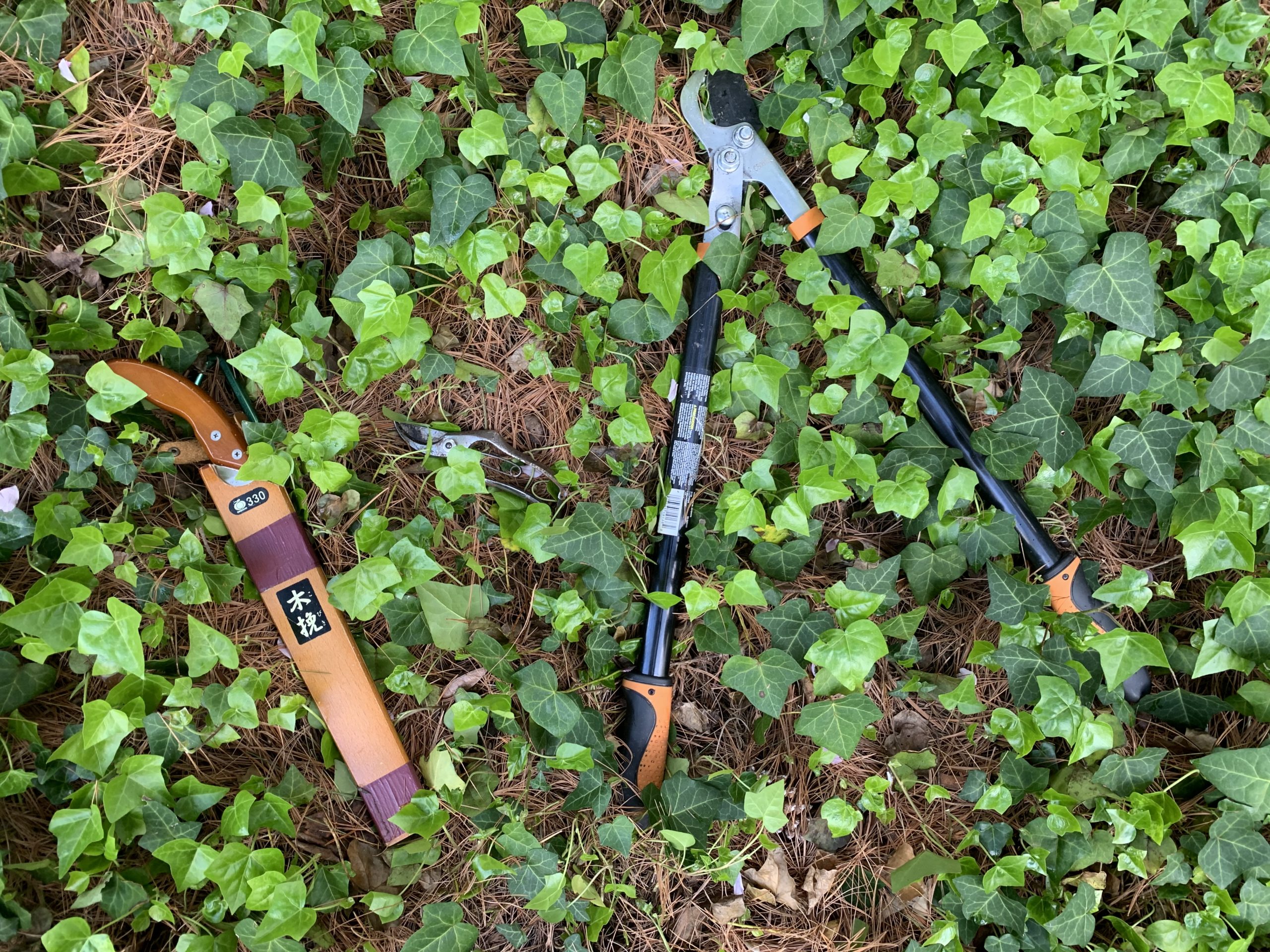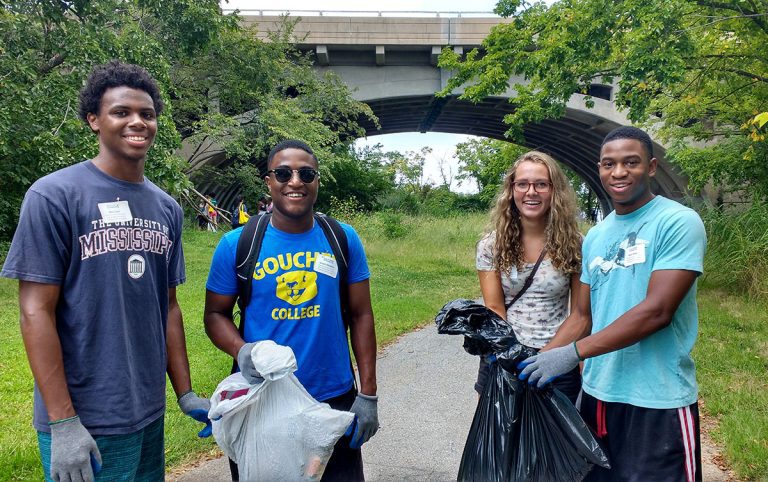Do your part. Protect our green spaces in Baltimore!
What are native, non-native, and invasive plant species?
Native species have co-evolved in specific ecosystems for thousands of years. Native plants are anchors of healthy, biodiverse communities. They have adapted to local soils and climate conditions. Each species plays a necessary role in the delicate web of life and preserves the balance and beauty of our ecosystems.
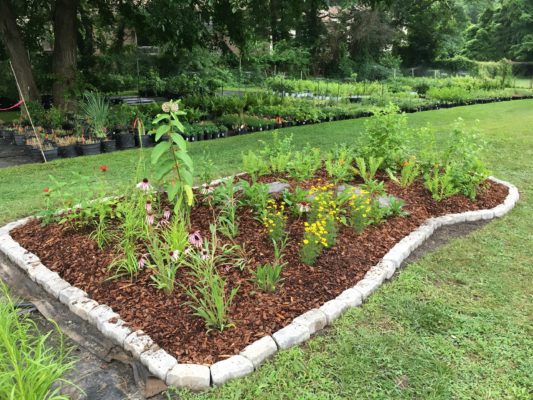
Photo: Our native pollinator garden at Herring Run Nursery supports a variety of bees, butterflies and birds.
Non-native or exotic species are introduced as a result of human activity. Due to globalization, these numbers have increased dramatically over the last century. Introduction of non-native species can occur knowingly, such as for aesthetics/ornamental purposes, fruit, or erosion control, but it can also happen accidentally through the shipment of goods. For example, Japanese stiltgrass was used as a packing material for porcelain and has since spread rapidly across our forests.
Many of these non-native plants only cause minor disruption to local ecosystems. Ginkgo trees are native to China, but are commonly planted along our city streets because they have narrow crowns and are tolerant of pollution and poor soils. They do not support any native wildlife, but they also do not spread rapidly and take over green spaces.
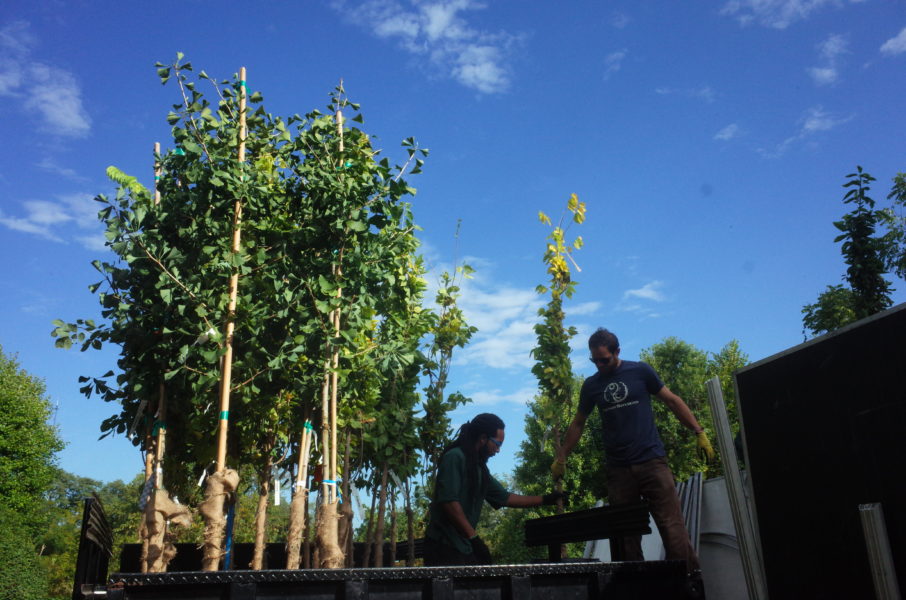
Photo: Unloading ginkgo trees at the TreeBaltimore nursery with our partners.
When non-native plants begin to out-compete and displace natives, they are deemed invasive. These introduced organisms did not co-evolve with other species. Our native wildlife cannot use them for food or habitat. They do not have natural controls or checks and balances. Invasive species severely reduce biodiversity, even deep in forests and undisturbed ecosystems. Invasive plants are opportunists. They often exhibit competitive characteristics. They can grow rapidly, produce vast numbers of seed with high seed viability, photosynthesize over extended growing seasons, and endure poor soil conditions. Many invasive plants thrive in ‘edge’ environments, which are increasingly common due to human caused disturbances such as deforestation and development. Invasive species sometimes reduce productivity of farms and other essential infrastructure. They are costly to control and pose a threat to our economy.

Photo: Invasive Jetbead (Rhodotypos scandens) has taken over vast areas of Druid Hill Park’s understory.

Photo: Porcelainberry vines (Ampelopsis glandulosa var. brevipedunculata) engulf young trees in a no-mow zone at an unmaintained planting site in Baltimore County.
A note on ethics and terminology:
When discussing invasive species at Blue Water Baltimore, we want to focus on ecosystem impact. Stressing plant origin and human-made borders between states and countries alone leads to problematic ideas about ‘otherness’ and alienation. It is wrong to vilify or condemn all non-native plants. Yet we have very real concerns about the impact of invasive species on our environment. In our field work and at our nursery, we are dedicated to growing and planting species that are native to the Chesapeake Bay region because they support our local food webs and are best adapted to our climate. We sometimes plant non-native species that do well here, but never invasives. Biodiversity is beautiful and fragile. Let’s protect and encourage it!!!
For a deeper dive into ideas about environmental impact vs plant origin, take a look at this article ‘Dont Judge Species by their Origins‘.
It’s easy to confuse some of these terms: native, indigenous, non-native, exotic, introduced, invasive…especially when we might think a plant is native because it’s commonly found in green spaces across our city and sold at local nurseries. However, many nurseries sell non-native and even invasive species. It is important to get educated about what you are purchasing and spreading across your yard and beyond. If you see invasive plants for sale, start a conversation with the business owner. Ask them to please stop distributing them! For more information on the status of specific species, check out these resources:
Plant Invaders of Mid-Atlantic Natural Areas
Native Plants for Wildlife Habitat and Conservation Landscaping
English Ivy: What is it?
English ivy is one of the most common non-native, invasive plant species that threatens our local habitats at all heights. It is easily recognizable by its heart-shaped, dark-green, waxy leaves.
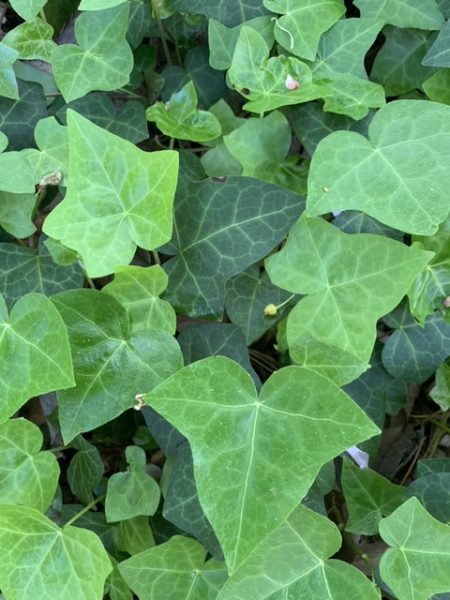
This ivy is a fast-growing evergreen perennial that can be found as a dense ground cover or a climbing vine.
As a ground cover, it aggressively displaces native vegetation by smothering open areas. Its leaves prevent sunlight from reaching native seedlings, thereby forming acres of monoculture and reducing biodiversity. English ivy also changes the chemical makeup of the soil, reducing germination of native plants.
How does English ivy pose a threat to our tree canopy?

Photo: English ivy ground cover that has gone unchecked and begun to climb tree trunks.
English ivy competes with trees for water and nutrients. As the vines climb up a tree trunk, they loosen the bark, providing an opening for pests and pathogens to enter and threaten the tree’s health. The vines also hold moisture against the trunk. This damp environment invites fungal disease and decay such as bacterial leaf scorch, a serious disease affecting trees including maples, oaks and elms.
Once they reach decent height, the vines spread outward and engulf branches, blocking sunlight to the leaves and slowly the tree. Heavy, bulky ivy at the tree top acts like the sail of a ship in the wind and puts trees at higher risk of breaking and falling in a storm.
At this late stage of infestation, the ivy begins producing fruit with seed. Seeds are mildly toxic, yet still eaten by birds who disperse the ivy across our city and beyond.
Note: English ivy may also cause structural damage to homes and buildings if it climbs up the walls.
Finally, trees look better and healthier without English Ivy growing up their trunks!
Protect trees in your community! Here’s how to properly remove English ivy:
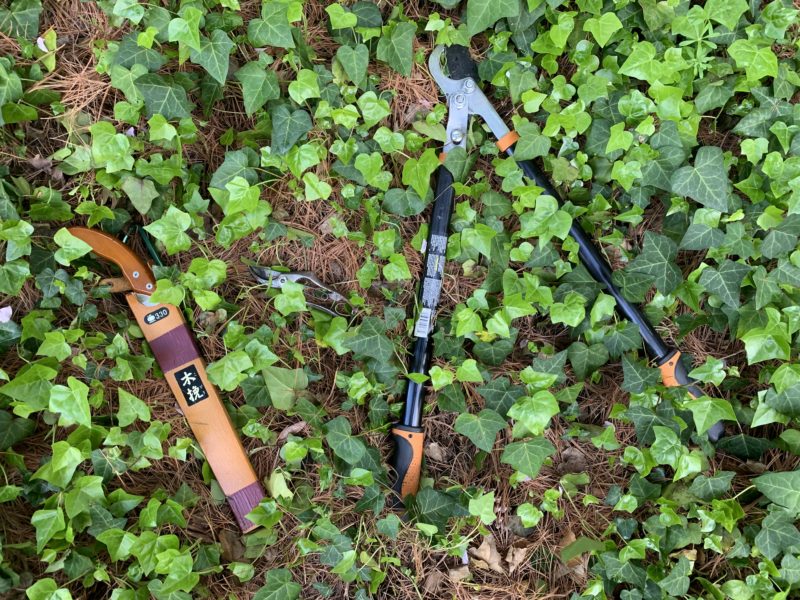
At Blue Water Baltimore, we advocate for mechanical removal (hand pulling). All herbicides are harmful to other plants and can enter our local waterways, so avoid applying chemical controls. While hand pulling is labor-intensive, it is a non-toxic solution. Plus, you get a good work out!
For complete removal, digging out the roots is essential. Vines often radiate from a central clump or node. This hearty plant will grow back from deep roots, so return to the site regularly to ensure eradication.
For climbing vines, use hand pruners, loppers or a handsaw. Cut all vines around the base of the tree. Make another cut 12 inches above the base to create a “window.” Carefully and gently remove this “window” to prevent damage to the tree bark. Do not pull vines from above: this can break tree branches. Severed vines will start turning brown in a month. For additional prevention, dig up roots around the base of the tree in a 2-foot “life saver ring.” Or, consider goats?!? Did you know that residents of Baltimore City can keep chickens, bees, rabbits, and dwarf, miniature, and pygmy goats. They eat everything!
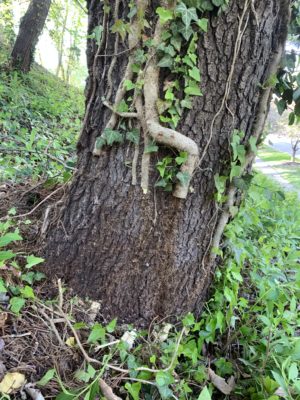
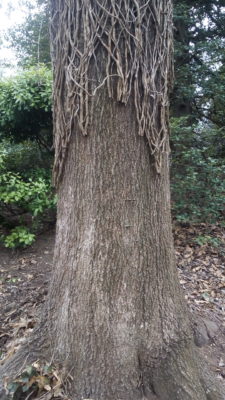
Photos: English ivy vines that were severed from their roots using the ‘window’ method.
For short term solutions to minimize spread, clip off flowers and fruits. English ivy can be contained to its juvenile phase with frequent and consistent mowing.
Note: Protect yourself! Always wear gloves and long sleeves. Mature English ivy vines can be easily confused with mature poison ivy vines! On close inspection, they are differentiated by color – poison ivy has reddish hairs covering the vine, while English ivy’s are brown. Best practice is to wash your hands and clothes after removal efforts.
Finally, bag up and throw away all the pieces of ivy that you remove – they can re-root if left on the ground!
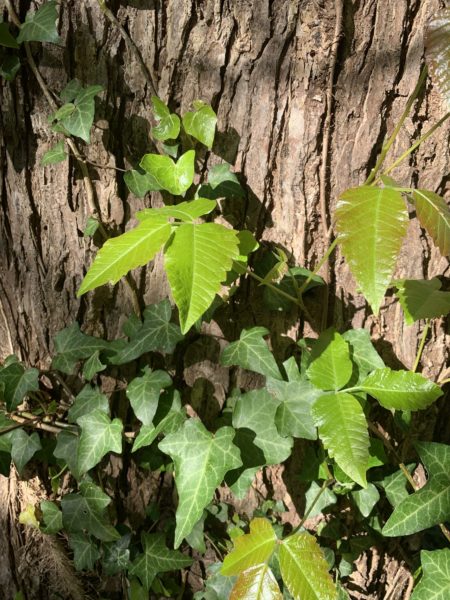
Photo: English ivy vines growing next to poison ivy vines. Beware: Leaves of three, let them be!
Go native! What to plant instead:
- Foam flower (Tiarella cordifolia)
- Lady fern (Athyrium filix-femina)
- Wild ginger (Asarum canadense)
- Pennsylvania sedge (Carex pensylvanica),
- Wild blue phlox (Phlox divaricata)
- Golden ragwort (Packera aurea)
Search by zip code to find plants that host the highest numbers of butterflies and moths to feed birds and other wildlife where you live.
These alternate native plants can be found at our very own Herring Run Nursery, recently reopened for delivery! Nursery sales fund our other programming and support clean water & strong communities, so take a look at our availability today.
Interested in learning more about invasive plants?
Become a Baltimore City Weed Warrior! Check out this awesome free educational course through TreeBaltimore. Learn how to identify and remove various invasive species and join a community of native plant advocates. Get certified to work in public spaces across the city!

Voila! You’ve saved a tree!
~Protecting and maintaining our mature tree canopy is essential for climate resiliency in our future city!~

